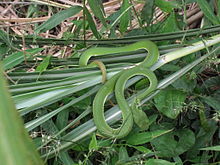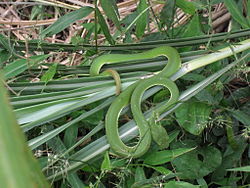pms
nòm ant ël fil


The dangerously venomous Trimeresurus stejnegeri is one of a group of morphologically similar green and arboreal Asian pitviper species known as "green pitvipers" (these species are sometimes segregated into a genus Viridovipera, e.g., V. stejnegeri; Malhotra and Thorpe 2004a,b,2005, Guo et al. 2009).Most green pitviper species share a common color pattern consisting of a uniform green coloration with a white lateral line on the first dorsal scale row, often also with red lateral lines and postocular stripes (Guo et al. 2009). Green pitvipers are among the most common venomous snakes in Asia and in many Asian countries account for a large fraction of snakebites, but working out the systematics and taxonomy of this group has been challenging. Malhotra and Thorpe (2004b) discuss these challenges in their analysis of the T. stejnegeri complex, as do Guo et al. (2009) in their review of Viridovipera.
Trimeresurus stejnegeri is known from China (central and southeastern), Taiwan, Vietnam, and possibly northeast Thailand. All reported records of this species from Myanmar apparently refer actually to T. yunnanensis. (Leviton et al. 2003) . Trimeresurus stejnegeri is nocturnal and has been reported to be very common around fast-flowing streams at elevations from 500-900 m. (Leviton et al. 2003 and references therein)
Guo and Zhao (2006) undertook an analysis of skull morphology of nine Asian pit vipers, including Viridovipera stejnegeri.
Leviton et al. (2003)provide a technical description of Trimeresurus stejnegeri: Scales in 21 longitudinal rows at midbody; 9-11 upper labials, first upper labials separated from nasals by a distinct suture; a single narrow supraocular, sometimes divided by transverse suture; 11-16 scales in a line between supraoculars; above bright to dark green, below pale green to whitish, the two separated by a bright bicolored orange or brown (below) and white (above) (males) or bicolored or white only (females) ventrolateral stripe, which occupies the whole of the outermost scale row and a portion ofthe second row; ventrals 150-174, subcaudals 54-77 (with a geographic component to variation?), all paired; hemipenes short, spinose beyond bifurcation. Total length: 750 mm; tail length: 145 mm.
Chhiah-bé-tai (ha̍k-miâ:Trimeresurus stejnegeri) sī to̍k-choâ ê chi̍t chióng.
Chhiah-bé-tai (ha̍k-miâ:Trimeresurus stejnegeri) sī to̍k-choâ ê chi̍t chióng.
Trimeresurus stejnegeri is a species of venomous pit viper endemic to Asia. Two subspecies are currently recognized, including the nominate subspecies described here.[3]
Common names for this pit viper include Stejneger's pit viper, Chinese pit viper, Chinese green tree viper,[4] bamboo viper, Chinese bamboo pitviper, 69 bamboo viper, and Chinese tree viper.[5] For other common, non-scientific names, see § Common names below.
The specific name, stejnegeri, is in honor of Leonhard Stejneger, the Norwegian-born, American herpetologist who worked at the Smithsonian Institution for over 60 years.[6]
Trimeresurus stejnegeri grows to a maximum total length of 75 centimetres (30 in), which includes a tail length of 14.5 centimetres (5.7 in). The males have hemipenes that are short and spinose beyond the bifurcation.[7]
The dorsal scales are arranged in 21 longitudinal rows at midbody. There are 9–11 upper labials, of which the first are separated from nasal scales by a distinct suture. The supraoculars are single, narrow, and sometimes divided by a transverse suture. There are 11–16 scales in a line between the supraoculars. The ventrals number 150–174, and the subcaudals are 54–77. All of the subcaudals are paired.[7]
The color pattern is bright to dark green above, pale green to whitish below, the two separated by a bright bicolored orange or brown (below) and white (above) (males) or bicolored or white only (females) ventrolateral stripe, which occupies the whole of the outermost scale row and a portion of the second row.[7]
Bamboo vipers are carnivores: they eat small rodents, birds, frogs, and lizards.
Yellow colored mutants have been reported.[8]
Common names for T. stejnegeri include bamboo viper, Chinese tree viper,[5] bamboo snake, Chinese green tree viper, Chinese bamboo viper, Stejneger's pit viper, Stejneger's palm viper, red tail snake,[4] Stejneger's bamboo pitviper,[9]
Trimeresurus stejnegeri is found in Northeast India) and Nepal through Myanmar and Laos to much of southern China (Yunnan, Sichuan, Gansu, Jiangxi, Jiangsu, Hunan, Hubei, Guizhou, Guangxi, Guangdong, Hainan, Fujian, Anhui, Zhejiang), Vietnam, and Taiwan.[1] The type locality was originally listed as "Shaowu, Fukien Province, China", and later emended to "N.W. Fukien Province" by Pope & Pope (1933) (Fukien being the former romanization of Fujian).[2]
The preferred natural habitat of T. stejnegeri is forest, at altitudes from sea level to 2,000 m (6,600 ft).[1]
Trimeresurus stejnegeri has a potent hemotoxin. The wound usually feels extremely painful, as if it had been branded with a hot iron, and the pain does not subside until about 24 hours after being bitten. Within a few minutes of being bitten, the surrounding flesh dies and turns black, highlighting the puncture wounds. The wound site quickly swells, and the skin and muscle become black due to necrosis. The size of the necrotic area depends on the amount of venom injected and the depth of the bite.
T. stejnegeri is viviparous.[3]
Trimeresurus stejnegeri is a species of venomous pit viper endemic to Asia. Two subspecies are currently recognized, including the nominate subspecies described here.
Common names for this pit viper include Stejneger's pit viper, Chinese pit viper, Chinese green tree viper, bamboo viper, Chinese bamboo pitviper, 69 bamboo viper, and Chinese tree viper. For other common, non-scientific names, see below.
Trimeresurus stejnegeri Trimeresurus generoko animalia da. Narrastien barruko Viperidae familian sailkatuta dago.
Trimeresurus stejnegeri Trimeresurus generoko animalia da. Narrastien barruko Viperidae familian sailkatuta dago.
Trimeresurus stejnegeri ou Vipère des Bambous est une espèce de serpents de la famille des Viperidae[1].
Cette espèce se rencontre[1] :
Selon Reptarium Reptile Database (13 décembre 2013)[2] :
Trimeresurus stejnegeri ou Vipère des Bambous est une espèce de serpents de la famille des Viperidae.
Rắn lục xanh (danh pháp hai phần: Trimeresurus stejnegeri)[4], là loài rắn độc thuộc phân họ Crotalinae. Loài này được Karl Patterson Schmidt mô tả khoa học lần đầu tiên năm 1925.[5]. Nó được tìm thấy ở Ấn Độ, Nepal, Myanma, Thái Lan, Trung Quốc, Đài Loan, Việt Nam. Có ba phân loài được công nhận, bao gồm cả phân loài danh định mô tả ở đây.[6]
Bề ngoài loài này tương tự với loài Trimeresurus popeiorum, nhưng bộ phận sinh dục của nó có cấu trúc khác nhau về cơ bản.
Loài này thường sống ở khu rừng trên núi có độ cao lên đến 2.845 m. Chúng là loài săn mồi về đêm và vừa sinh sống trên cây vừa sinh sống trên mặt đất. Đôi khi chúng nghỉ hoặc săn lùng thức ăn gần các con suối trên núi. Thức ăn của chúng là động vật có vú nhỏ, chim, thằn lằn.
Rắn lục xanh (danh pháp hai phần: Trimeresurus stejnegeri), là loài rắn độc thuộc phân họ Crotalinae. Loài này được Karl Patterson Schmidt mô tả khoa học lần đầu tiên năm 1925.. Nó được tìm thấy ở Ấn Độ, Nepal, Myanma, Thái Lan, Trung Quốc, Đài Loan, Việt Nam. Có ba phân loài được công nhận, bao gồm cả phân loài danh định mô tả ở đây.
Bề ngoài loài này tương tự với loài Trimeresurus popeiorum, nhưng bộ phận sinh dục của nó có cấu trúc khác nhau về cơ bản.
Loài này thường sống ở khu rừng trên núi có độ cao lên đến 2.845 m. Chúng là loài săn mồi về đêm và vừa sinh sống trên cây vừa sinh sống trên mặt đất. Đôi khi chúng nghỉ hoặc săn lùng thức ăn gần các con suối trên núi. Thức ăn của chúng là động vật có vú nhỏ, chim, thằn lằn.
赤尾青竹絲(學名:Trimeresurus stejnegeri)又名福建竹葉青蛇、中國竹葉青蛇,是一種分佈於印度、尼泊爾、緬甸、泰國、中國大陸、臺灣的蝮亞科竹葉青屬毒蛇,有三個亞種,為台灣六大毒蛇之一。[4]。
中小型蛇類,最大體長約90公分,體型瘦長,頭部呈三角形,頸部細長,眼睛為紅色,眼睛和鼻孔間有可感熱的頰窩。身體背部為翠綠色或深綠色,腹側有一條白色細縱線,雄性在白線下還有一條紅縱線,腹部為淡黃綠色,尾部為磚紅色。
白天夜晚均會活動,但以夜間活動較為頻繁。通常以蛙類、蜥蜴、鳥類、老鼠及鼩鼱為食,其中又以蛙類為主。以卵胎生方式繁殖,一般於秋季交配,隔年的夏季生產。每窩可產2~15條幼蛇,初生幼蛇長約26公分,一年半左右即可達到性成熟[5]。
雖然毒性較弱,但因為體色與植物相近,是台灣咬人紀錄最多的蛇類。毒液中含有出血性毒素,被咬的傷口會腫痛、發癢、瘀血或起水泡。[5]
棲地形態極為廣泛,由低海拔次生林到2,000多公尺山區的各類型環境皆能發現到牠的蹤跡。[6]
|access-date=中的日期值 (帮助) 赤尾青竹絲(學名:Trimeresurus stejnegeri)又名福建竹葉青蛇、中國竹葉青蛇,是一種分佈於印度、尼泊爾、緬甸、泰國、中國大陸、臺灣的蝮亞科竹葉青屬毒蛇,有三個亞種,為台灣六大毒蛇之一。。

 保全状況評価[1] LEAST CONCERN
保全状況評価[1] LEAST CONCERN 分類 界 : 動物界 Animalia 門 : 脊索動物門 Chordata 亜門 : 脊椎動物亜門 Vertebrata 綱 : 爬虫綱 Reptilia 目 : 有鱗目 Squamata 科 : クサリヘビ科 Viperidae 亜科 : マムシ亜科 Crotalinae 属 : アジアハブ属 Trimeresurus 種 : タイワンアオハブ
分類 界 : 動物界 Animalia 門 : 脊索動物門 Chordata 亜門 : 脊椎動物亜門 Vertebrata 綱 : 爬虫綱 Reptilia 目 : 有鱗目 Squamata 科 : クサリヘビ科 Viperidae 亜科 : マムシ亜科 Crotalinae 属 : アジアハブ属 Trimeresurus 種 : タイワンアオハブタイワンアオハブ Trimeresurus stejnegeri はマムシ亜科に属する毒蛇の一種。アジア熱帯域に分布する。
種小名 stejnegeri はスミソニアン学術協会の爬虫類学者だったLeonhard Hess Stejnegerへの献名である。
英名としては、"bamboo viper"・"Chinese tree viper"[4]・"bamboo snake"・"Chinese green tree viper"・"Chinese bamboo viper"・"Stejneger's pit viper"・"Stejneger's palm viper"・"red tail snake"[5]・"Stejneger's bamboo pitviper"[6]などがある。台湾産個体は"Formosan bamboo viper"・"Taiwan green tree viper"とも呼ばれる[7]。
最大で全長75cm、尾長14.5cmになる。雄の半陰茎は短く、分岐点よりも先まで棘を持つ[8]。
体鱗は体中央部で21列。上唇板は9-11で、吻端板と鼻板の間には継ぎ目がある。前眼鱗は単独で細く、横線が入ることがある。両前眼鱗間には11-16の鱗がある。腹板は150-174。尾下板は54-77個で対をなす[8]。
背面は明緑色から暗緑色、腹面は淡緑色から白。体側には上側が白、下側が橙から茶色(雌では白のみのこともある)の帯が走る。この帯は、体の最も外側の鱗列とその下の鱗列に位置する[8]。
夜行性、半樹上性で、山地林の渓流周辺や水田に見られる。おそらくカエルが主食だが、小型哺乳類・鳥類・トカゲも食べる。産仔数は3-10[1]。
強力な出血毒を持つ。
アッサム州・ネパールからミャンマー・タイ王国・ラオス・中国南部・台湾に分布する[2][9]。Leviton et al. (2003) はベトナムにも分布するとしている[8]。基産地は当初「福建省邵武市」とされたが、その後Pope & Pope (1933) によって「福建省北西」と修正された[2]。
|date= (help)CS1 maint: Uses authors parameter